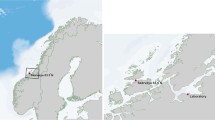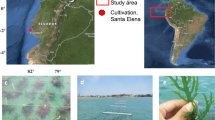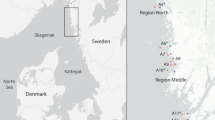Abstract
Saccharina latissima is an economically and ecologically important native kelp. As its limited supply from wild stock cannot meet increasing current and future demands, methods for its cultivation in the ocean need to be developed. This kelp is now beginning to be farmed off the Atlantic coast of Spain using a regular method similar to the “forced cultivation” technique used with Asian kelps (kombu). Its cultivation is also a growing enterprise in other European countries. In this study, the open-sea farming of S. latissima using the transplanting method is tested on a commercial scale. This cultivation method has not been studied with kelp species outside Asian waters. The tested method includes the following steps: indoor production of seedlings, pre-culture in greenhouse tanks, and open-sea cultivation by transplanting young fronds. Results demonstrate that open-sea cultivation using transplanted young fronds is a technically and biologically viable method. The mean yield obtained (7.8 kg fresh wt per meter rope equivalent to 45.6 t fresh wt per hectare farm) is satisfactory, considering the low densities of transplanted fronds (25–30 fronds per meter rope). Moreover, these values are comparable to those reported in previous cultivations with this species, as well as in the farming of similar kelps. The transplanting method used in conjunction with the regular cultivation method has valuable practical applications for the commercial farming of S. latissima.




Similar content being viewed by others
References
Adams JM, Gallagher JA, Donnison IS (2009) Fermentation study on Saccharina latissima for bioethanol production considering variable pre-treatments. J Appl Phycol 21:569–574
Andersen GS, Steen H, Christie H, Fredriksen S, Moy FE (2011) Seasonal patterns of sporophyte growth, fertility, fouling, and mortality of Saccharina latissima in Skagerrak Norway: implications for forest recovery. J Mar Biol. doi:10.1155/2011/690375
Bárbara I, Cremades J, Calvo S, López-Rodríguez MC, Dosil J (2005) Checklist of the benthic marine and brackish Galician algae (NW Spain). Anales Jard Bot Madrid 62:69–100
Bekkby T, Moy FE (2011) Developing spatial models of sugar kelp (Saccharina latissima) potential distribution under natural conditions and areas of its disappearance in Skagerrak. Estuar Coast Shelf Sci 95:477–483
Bolton JJ, Lüning K (1982) Optimal growth and maximal survival temperatures of Atlantic Laminaria species (Phaeophyta) in culture. Mar Biol 66:89–94
Breeman AM (1988) Relative importance of temperature and other factors in determining geographic boundaries of seaweeds: experimental and phenological evidence. Helgoländer Meeresunters 42:199–241
Brinkhuis BH, Breda VA, Tobin S, Macler BA (1983) New York marine biomass program-culture of Laminaria saccharina. J World Maricult Soc 14:360–379
Buck BH, Buchholz CM (2004) The offshore-ring: a new system design for the open ocean aquaculture of macroalgae. J Appl Phycol 16:355–368
Buck BH, Buchholz CM (2005) Response of offshore cultivated Laminaria saccharina to hydrodynamic forcing in the North Sea. Aquaculture 250:674–691
Carney LT, Waaland JR, Klinger T, Ewing K (2005) Restoration of the bull kelp Nereocystis luetkeana in nearshore rocky habitats. Mar Ecol Prog Ser 302:49–61
Correa JA, Lagos NA, Medina MH, Castilla JC, Cerda M, Ramirez M, Martinez E, Faugeron S, Andrade S, Pinto R, Contreras L (2006) Experimental transplants of the large kelp Lessonia nigrescens (Phaeophyceae) in high-energy wave exposed rocky intertidal habitats of northern Chile: experimental, restoration and management applications. J Exp Mar Biol Ecol 335:13–18
Cremades J, Freire O, Baamonde S, Salinas JM, Fuertes C (2007) Nuevo método para el cultivo industrial de Laminaria saccharina (Laminariales, Phaeophyta) en las costas gallegas. In: Cerviño Eiroa A, Guerra Díaz A, Pérez Acosta C (eds) XI Congreso Nacional de Acuicultura. Consellería de Pesca e Asuntos Marítimos, Xunta de Galicia, Vigo, Spain, pp 559–562 (in Spanish with English abstract)
Chapman ARO, Markham JW, Lüning K (1978) Effect of nitrate concentration on the growth and physiology of Laminaria saccharina (Phaeophyta) in culture. J Phycol 14:195–198
Chugaynova VA, Gorennikov SP (1996) Mariculture of Laminaria saccharina in the White Sea. Hydrobiol J 32:63–67
Dayton PK (1975) Experimental evaluation of ecological dominance in a rocky intertidal algal community. Ecol Monogr 45:137–159
Druehl LD, Baird R, Lindwall A, Lloyd KE, Pakula S (1988) Longline cultivation of some Laminariaceae in British Columbia, Canada. Aquacult Fish Manag 19:253–263
FAO (1989) Culture of kelp (Laminaria japonica) in China. In: Scoggan J, Zhimeng Z, Feijiu W (eds) Laminaria seafarming in China. FAO Training Manual 89/5 (RAS/86/024), Electronic edition. Available at: http://www.fao.org/docrep/field/003/AB724E/AB724E00.htm. Accessed 1 Jul 2013
FAO (2012) The state of world fisheries and aquaculture. FAO Publishing Management Service, Rome
Forbord S, Skjermo J, Arff J, Handå A, Reitan KI, Bjerregaard R, Lüning K (2012) Development of Saccharina latissima (Phaeophyceae) kelp hatcheries with year-round production of zoospores and juvenile sporophytes on culture ropes for kelp aquaculture. J Appl Phycol 24:393–399
Fortes MD, Lüning K (1980) Growth rates of North Sea macroalgae in relation to temperature, irradiance and photoperiod. Helgoländer Meeresunters 34:15–29
Gerard VA (1997) The role of nitrogen nutrition in high-temperature tolerance of the kelp, Laminaria saccharina (Chromophyta). J Phycol 33:800–810
Gorostiaga JM, Santolaria A, Secilla A, Casares C, Díez I (2004) Check-list of the Basque coast benthic algae (North of Spain). Anales Jard Bot Madrid 61:155–180
Grasshoff K, Ehrhardt M, Kremling K (1983) Methods of seawater analysis, 2nd edn. Verlag Chemie, Weinheim
Hasegawa M, Unno Y (2010) Restoration of Ecklonia cava forest on Hainan coast, Shizuoka Prefecture. Bull Fish Res Agen 32:119–124
Hernandez-Carmona G, Garcia O, Robledo D, Foster M (2000) Restoration techniques for Macrocystis pyrifera (Phaeophyceae) populations at the southern limit of their distribution in Mexico. Bot Mar 43:273–284
Hunt R (1982) Plant growth curves. Edward Arnold, London
Jones CG, Lawton JH, Shachak M (1997) Positive and negative effects of organisms as physical ecosystem engineers. Ecology 78:1946–1957
Kain (Jones) JM, Holt TJ, Dawes CP (1990) European Laminariales and their cultivation. In: Yarish C, Penniman CA, Van Petten P (eds) Economically important plants of the Atlantic: their biology and cultivation. Connecticut Sea Grant College Program. University of Connecticut, Groton, pp 95–111
Kawashima S (1984) Kombu cultivations in Japan for human foodstuff. Jpn J Phycol 32:379–394
Kawashima S (1993) Cultivation of the brown alga, Laminaria 'kombu'. In: Ohno M, Critchley AT (eds) Seaweed cultivation and marine ranching, vol 4. Japan International Cooperation Agency (JICA), Jokosuka, pp 25–40
Kelly MS, Owen PV, Pantazis P (2001) The commercial potential of the common sea urchin Echinus esculentus from the west coast of Scotland. Hydrobiologia 465:85–94
Kraan S (2013) Mass-cultivation of carbohydrate rich macroalgae, a possible solution for sustainable biofuel production. Mitig Adapt Strat Global Change 18:27–46
Lee JA, Brinkhuis BH (1986) Reproductive phenology of Laminaria saccharina (L.) Lamour. (Phaeophyta) at the southern limit of its distribution in the northwestern Atlantic Ocean. J Phycol 22:276–285
Lüning K (1990) Seaweeds: their environment, biogeography and ecophysiology. Wiley, New York
Lüning K, Freshwater W (1988) Temperature tolerance of Northeast Pacific marine algae. J Phycol 24:310–315
Mairh OP, Ohno M, Matsuoka M (1991) Culture of brown alga Laminaria japonica (Phaeophyta, Laminariales) in warm waters of Shikoku, Japan. Indian J Mar Sci 20:55–60
Müller R, Laepple T, Bartsch I, Wiencke C (2009) Impact of oceanic warming on the distribution of seaweeds in polar and cold-temperate waters. Bot Mar 52:617–638
Pehlke C, Bartsch I (2008) Changes in depth distribution and biomass of sublittoral seaweeds at Helgoland (North Sea) between 1970 and 2005. Clim Res 37:135–147
Pérez-Ruzafa I, Izquierdo JL, Araújo R, Sousa Pinto I, Pereira L, Bárbara I (2003) Mapas de distribución de algas marinas de la Península Ibérica e Islas Baleares. XVII. Laminaria rodriguezii Bornet y adiciones a los mapas de L. hyperborea (Gunner.) Foslie, L. ochroleuca Bach. Pyl. y L. saccharina (L.) Lamour. (Laminariales, Fucophyceae). Bot Complutensis 27:155–164 (in Spanish with English abstract)
Perez R, Kaas R, Barbaroux O (1984) Culture expérimentale de l'algue Undaria pinnatifida sur les côtes de France. Sci Pêche 343:3–15 (in French with English abstract)
Perez R, Kaas R, Barbaroux O, Arbault S, Le Bayon N, Moigne JY (1990) Technique de culture pour les cotes bretonnes de l'algue alimentaire Undaria pinnatifida Tableau de marché - étude économique. IFREMER, Plouzane (in French)
Perez R, Kaas R, Campello F, Arbault S, Barbaroux O (1992) La culture de l'algue Undaria pinnatifida (Harvey) Suringar. In: La culture des algues marines dans le monde. Service de la Documentation et des Publications (SDP), IFREMER, Plouzane, France, pp 425–462 (in French)
Peteiro C, Freire Ó (2009) Effect of outplanting time on the commercial cultivation of the kelp Laminaria saccharina at the southern limit in the Atlantic coast, N.W. Spain. Chin J Oceanol Limnol 27:54–60
Peteiro C, Freire Ó (2011) Offshore cultivation methods affects blade features of the edible seaweed Saccharina latissima in a bay of Galicia, Northwest Spain. Russ J Mar Biol 37:319–323
Peteiro C, Freire Ó (2012) Observations on fish grazing of the cultured kelps Undaria pinnatifida and Saccharina latissima (Phaeophyceae, Laminariales) in Spanish Atlantic waters. AACL Bioflux 5:189–196
Peteiro C, Freire Ó (2013) Biomass yield and morphological features of the seaweed Saccharina latissima cultivated at two different sites in a coastal bay in the Atlantic coast of Spain. J Appl Phycol 25:205–213
Peteiro C, Salinas JM, Freire Ó, Fuertes C (2006) Cultivation of the autoctonous seaweed Laminaria saccharina off the galician coast (NW Spain): production and features of the sporophytes for an annual and biennial harvest. Thalassas 22:45–52
Salinas JM (1991) Spray system for re-attachment of Gelidium sesquipedale (Clem.) Born. et Thur. (Gelidiales, Rhodophyta). Hydrobiologia 221:107–117
Salinas JM (2011) Cultivo de laminariales y acuicultura multitrófica. In: Vázquez Ferreiro U, Incera Filgueira M, Fernández Otero R, Moroto Leal J (eds) Macroalgas en la acuicultura multitrófica integrada peninsular. Centro Tecnológico del Mar Fundación CETMAR, Vigo, pp 29–51 (in Spanish)
Salinas JM, Cremades J, Peteiro C, Fuertes C (2006) Influencia de las características del hilo de semilla en el cultivo industrial de Undaria pinnatifida y Laminaria saccharina (Laminariales, Phaeophyta). Bol Inst Esp Oceanogr 22:65–72 (in Spanish with English abstract)
Sanbonsuga Y (1984) Studies of the growth of forced Laminaria. Bull Hokkaido Reg Fish Res Lab 49:1–78
Sanderson JC, Dring MJ, Davidson K, Kelly MS (2012) Culture, yield and bioremediation potential of Palmaria palmata (Linnaeus) Weber & Mohr and Saccharina latissima (Linnaeus) C.E.Lane, C.Mayes, Druehl & G.W.Saunders adjacent to fish farm cages in north west Scotland. Aquaculture 354:128–135
Sauvageau C (1897) Note préliminaire sur les algues marines du Golfe de Gascogne. J Bot 11:1–64
Steneck RS, Graham MH, Bourque BJ, Corbett D, Erlandson JM, Estes JA, Tegner MJ (2002) Kelp forest ecosystems: biodiversity, stability, resilience and future. Environ Conserv 29:436–459
Subandar A, Petrell RJ, Harrison PJ (1993) Laminaria culture for reduction of dissolved inorganic nitrogen in salmon farm effluent. J Appl Phycol 5:455–463
Tasende MG, Rodríguez González LM (2003) Economic seaweeds of Galicia (NW Spain). Thalassas 19:17–25
Thompson SA, Knoll H, Blanchette CA, Nielsen KJ (2010) Population consequences of biomass loss due to commercial collection of the wild seaweed Postelsia palmaeformis. Mar Ecol Prog Ser 413:17–31
Titlyanov EA, Titlyanova TV (2010) Seaweed cultivation: methods and problems. Russ J Mar Biol 36:227–242
Troell M, Robertson-Andersson D, Anderson RJ, Bolton JJ, Maneveldt G, Halling C, Probyn T (2006) Abalone farming in South Africa: An overview with perspectives on kelp resources, abalone feed, potential for on-farm seaweed production and socio-economic importance. Aquaculture 257:266–281
Tseng CK (1987) Laminaria mariculture in China. In: Doty MS, Caddy JF, Santelices B (eds) Case studies of seven commercial seaweed resources. FAO Fisheries, Rome, pp 239–263
van den Hoek C (1982) The distribution of benthic marine algae in relation to the temperature regulation of their life histories. Biol J Linn Soc 18:81–144
van den Hoek C, Donze M (1966) The algal vegetation of the rocky côte basque (SW France). Bull Centr Etud Rech Sci Biarritz 6:289–319
van den Hoek C, Mann D, Jahns HM (1996) Algae: an introduction to phycology. Cambridge University Press, Cambridge, UK
Vásquez JA, Santelices B (1990) Ecological effects of harvesting Lessonia (Laminariales, Phaeophyta) in Central Chile. Hydrobiologia 204:41–47
Acknowledgments
We would like to acknowledge the assistance of the technical staff of the Instituto Español de Oceanografía (IEO) in Santander. We would also like to thank Carmen Rodríguez Puente (IEO, Santander) and the Meteorological Observatory of Santander for providing environmental data. Special thanks to A. Secilla for his assistance in the elaboration of Fig. 3. Finally, the authors thank Lori De Hond for their linguistic assistance and anonimous reviewers for their valuable comments and suggestions.
Author information
Authors and Affiliations
Corresponding author
Rights and permissions
About this article
Cite this article
Peteiro, C., Sánchez, N., Dueñas-Liaño, C. et al. Open-sea cultivation by transplanting young fronds of the kelp Saccharina latissima . J Appl Phycol 26, 519–528 (2014). https://doi.org/10.1007/s10811-013-0096-2
Received:
Revised:
Accepted:
Published:
Issue Date:
DOI: https://doi.org/10.1007/s10811-013-0096-2




